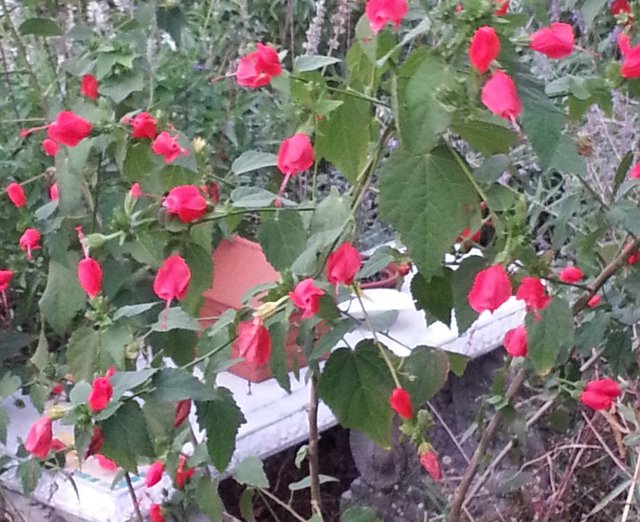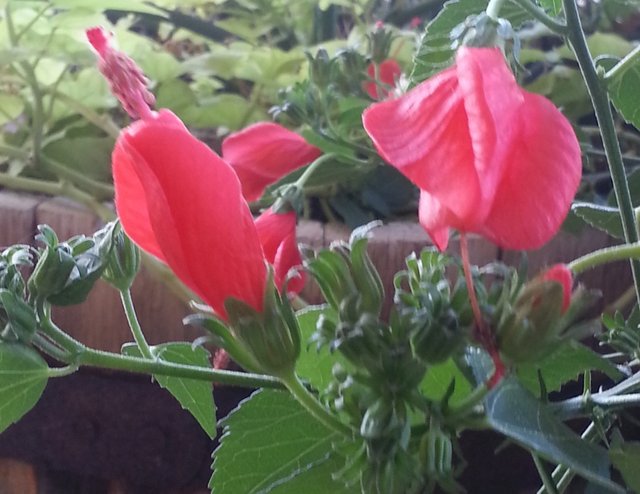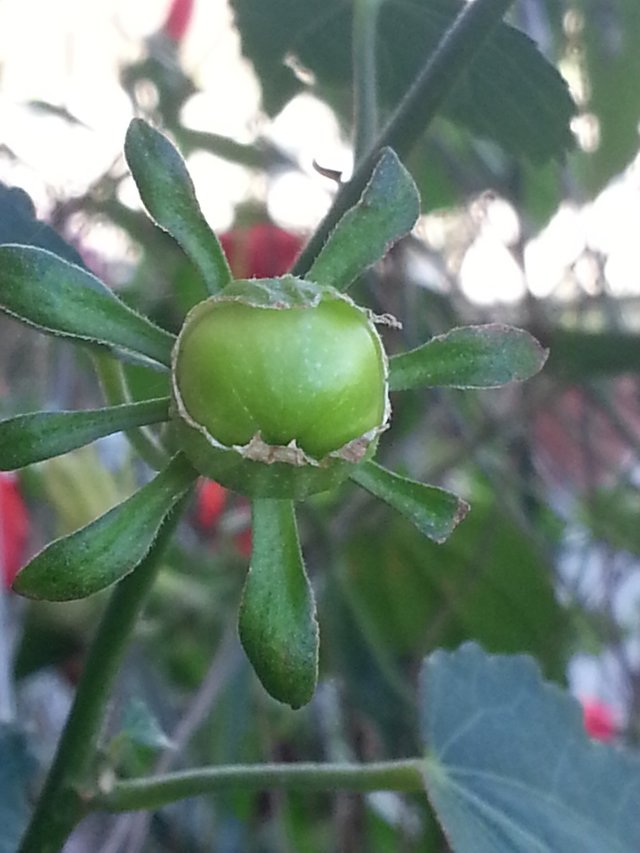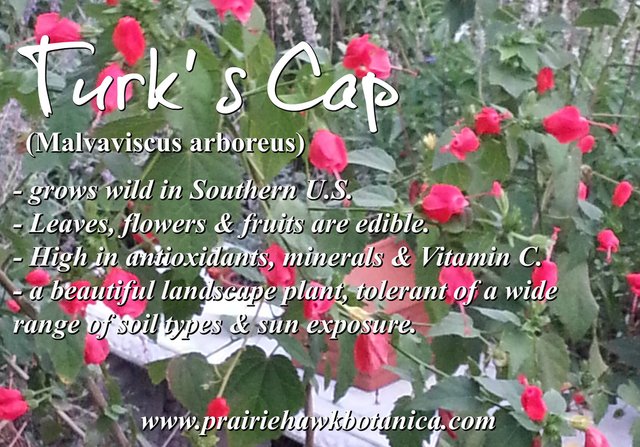Edible Landscaping: Turk's Cap

Turk's cap (Malvaviscus arboreus) in autumn, covered in blooms. Image by Jennifer Capestany.
In my Edible Landscaping series, we take a look at plants that marry form with function. All plants in this series have value as beautiful landscaping plants, while also being useful for food or medicine.
Turk's cap is in full bloom right now in my home state of Texas. Bright red, unique-looking blooms grow prolifically from the upper foliage of this hardy perennial. Turk's cap, also called Mexican apples, wax mallow, or Scotchman's purse, is favored as a landscaping plant because of its beauty, hardiness, and reliable performance through a range of climate and soil conditions. Hummingbirds and butterflies also love Turk's cap. This garden beauty's usefulness doesn't end there though. Turk's Cap shines as an edible plant, making it one of my favorite plants to have in a functional garden.
Growing Turk's Cap
Turk's cap loves the temperate states, generally growing well in USDA growing zones 7 and up. It will grow as a shrub if it can, usually about 3-5 feet high and as wide. Turk's cap prefers part shade and well-draining soil; however, the reason why this is such a popular landscaping plant is its versatility.
Turk's cap will grow in a range of soils, including sandy or black clay soils. My soil here in North Texas is primarily black clay, known for unbelievable stickiness when it's wet, and poodle-swallowing cracks when it's dry. The Turk's cap that I planted into this native soil wasn't the least bit intimidated by it.
Sun exposure also doesn't pose a big problem for this tough yet pretty native plant. Turk's cap prefers part shade, but it will grow in full shade or full sun if planted there. You can find it thriving around tree trunks, along porches, and in sunny flowerbeds. It's a highly adaptable plant.
I've read that being planted in full burning Texas sun can cause the plant to grow in a more leggy fashion than a shrub. My personal experience is somewhat counter to this. You can see my 2 year old Turk's cap in all of the photos in this article. It's well on its way to becoming a shrub, though I do have stems that grow about 5 feet high, giving the plant a slightly leggy look. Mine is planted towards the back of my flowerbed, but in full, west-facing sun conditions.
Turk's cap is drought tolerant, and very heat tolerant. It will appreciate regular watering though. Remember that in order to create as gorgeous a plant as possible in your garden, you want to mimic its ideal growing conditions as much as you can.
Red is the most common color, and is the wild type for this plant. Pink and white variants do also exist.
Depending on how mild the winter is, you can start to see new growth at the base of the plant in late winter or early spring. Turk's cap typically flowers in summer and fall. It will generate masses of blooms that keep on coming often deep into November. Once the cold temperatures hit, Turk's cap will lose its leaves and go dormant.

Turk's cap blooms. Image by Jennifer Capestany.
Caring for Turk's Cap
As mentioned already, while Turk's cap can tolerate a bit of drought, regular watering is best if possible.
This plant reseeds readily and can start to take over your garden if you let it. The blooms turn into small red fruits. If you don't want Turk's cap dominating your flowerbeds, then harvest those fruits before they shrivel and drop off of the plant. I'll get to what you can do with them in just a bit.
Once the cold temperatures hit, Turk's cap will lose it leaves. No need to dig it up. It's a perennial, so it should come back in early spring. I tend to clip mine down in late autumn to within about 5 inches of the ground. I have found that it benefits from annual clipping, growing back fuller the next season.
As far as making more little Turk's caps goes, root division, growing from seed, and softwood propagation all work nicely. If your Turk's cap is spreading a little too far, dig up a portion of the plant with roots attached, and give it away to a friend. You can also grow more from seed, or propagate more from cuttings. Turk's cap propagates so well in fact that many have had great success without the need for rooting hormone.
Harvesting & Wild Foraging for Turk's Cap
The leaves, flowers, and fruit of Turk's cap are edible. How great is that! As if this plant wasn't worthy of being in your garden just for its beauty and resilience, it's also food.
The mineral-rich leaves are edible raw or cooked. They have a surprisingly light taste. They can be tough as they get older and larger though. Harvest the younger leaves to minimize this, and gently steam them to further reduce their texture. As a rule, you can treat Turk's cap leaves much as you would grape leaves.
The flowers are edible, raw or cooked. I find them to be slightly sweet, and a little mucilaginous like its relative, okra. You can toss them into salads for gorgeous color, or add them to pancakes and stir fries (at the last moment before tossing and serving). You can also use the flowers fresh or dried to make an herbal tea. The blooms are known to be high in antioxidants.

The unripe fruit of Turk's cap. Wait until it's red in color before eating it. Image by Jennifer Capestany.
The small fruit of Turk's cap, known as Mexican apples, are sweet and safe to eat, including the seeds within. The fruit is ripe when it's red-orange in color. Eat them quickly! Unlike the "apples" that they're named for, Turk's cap fruit doesn't last long after picking. They will also drop off and reseed happily if you let them. The fruit is high in Vitamin C. In addition to fresh eating, you can make herbal tea and preserves with Turk's cap fruit.
Turk's cap is native to the Americas, found growing wild from the southern states of the U.S.A., through Mexico and Central America. It tends to prefer dappled sun and well-draining soil, so if you are wild foraging for Turk's cap, look in woodlands, along stream beds, and at the forest edges.
Don't forget the Rules of Foraging!
Responsible foragers always adhere to a few rules when they go out to collect wild edibles or medicinals.
- All land is owned by someone or some entity. Make sure that you have permission or legal right to harvest on the land.
- Never harvest a plant that you have not identified with 100% certainty. If in doubt, leave it be. Bringing a guidebook along with you is an excellent idea.
- Never take so much of a plant that it cannot recover. Rule of thumb in the wild foraging world is to only take about 10% from plants that clearly have not already been recently harvested from. Remember to always leave some blooms to go to seed.
- It's also inadvisable to eat wild edibles from locations that may have been poisoned for weeds. You don't want that in you.
Humans are meant to be Earth's stewards. So have fun! But be wise.

Putting all of this information together, it's clear that Turk's cap, an Americas original, is a functional garden winner. It's beautiful, highly adaptable, easy to care for, and a food source. Foragers aren't left out either, as you can easily find it growing wild in temperate regions of the Americas. If you're a practical gardener who favors plants that perform on multiple levels, then give Turk's cap a try.
Health Disclaimer: You own yourself. Always do your research when trying out new foods, especially if you have a health condition, and/or are on prescription medications. Wild edibles are nutrient dense. Most of us are not used to that. Go slowly, not only to test for reaction, but also to give your body a chance to accustom to the richness of wild edibles. No information on this website should be considered medical advice, nor should the information here be considered a complete listing of all possible plant components or dangers. Neither Prairie Hawk Botanica nor Jennifer Capestany will be responsible for injury. Anything that you learn from Prairie Hawk Botanica, its blog, or Jennifer Capestany must be considered informational only. Article originally published on Prairie Hawk Botanica's Blog. Shared by me, the original author and owner.

Author: Jennifer Capestany
Jennifer is a clinical herbalist and health coach, specializing in autoimmune diseases like rheumatoid arthritis. Her interest in plant medicine led Jennifer to spend years studying herbology, physiology, and nutrition. She works one-on-one with her clients via her herbalist and health coaching business, Prairie Hawk Botanica. Jennifer lives on a homestead in rural Texas with her husband, 2 children, and various animals. In her spare time she loves to be in her large herb and vegetable garden. Sharing herb knowledge and her love of natural healing with others is her calling.
Upvoted by @gardening-trail
Thank you for following and upvoting @gardening-trail
Read our guidelines here
Upvoted by @foraging-trail
Thank you for following and upvoting @foraging-trail
You can find out more about the Steemit Foraging community and guidelines for being upvoted by the @foraging-trail here and here.
I use a lot of mallow-family flowers, fresh-picked, from early summer until the frost ends it all -- hollyhocks, rose-of-sharon, hibiscus. I see where you suggest drying the Turks Cap. Can you compare those to hibiscus or other mallow-family flowers? I've had good success with hibiscus, but they have more flavor than hollyhocks or rose-of-sharon, in my experience. I'd like to see what your Turks Cap tea looks like! :D
I use a lot of mallow-family leaves, too. My favorites are the rose-of-sharon and common mallow. They are so abundant.
I've grown hollyhocks and hibiscus this year too.
I like to keep mallow growing in my garden in case I need the roots for medicine, though, as you mentioned, the leaves and flowers offer up benefits too. Now that you've brought it up, the flavor of Turk's cap flower does remind me of mallow blooms. The tea for me is kind of a yellow-pink color, light tasting, floral in scent. It's fine by itself, but in my opinion would probably shine best in a blend.
Great post! My son devours the flowers and fruit from the Turk’s Cap in our yard. Attracts the hummingbirds and butterflies, too!
Yes, it does, and I meant to mention that in this article. Thanks for the reminder! This is what happens when you stay up late to finish a write-up. Stuff gets forgotten. :/